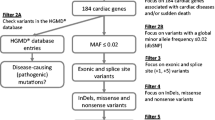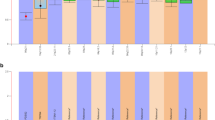Abstract
Annually, thousands of sudden deaths in individuals under 35 years remain unexplained following comprehensive medico-legal autopsy. Previously, post-mortem genetic analysis by Sanger sequencing of four major cardiac channelopathy genes revealed that approximately one-fourth of these autopsy-negative sudden unexplained death in the young (SUDY) cases harbored an underlying mutation. However, there are now over 100 sudden death-predisposing cardiac channelopathy-, cardiomyopathy-, and metabolic disorder-susceptibility genes. Here, we set out to determine whether post-mortem whole exome sequencing (WES) is an efficient strategy to detect ultra-rare, potentially pathogenic variants. We performed post-mortem WES and gene-specific analysis of 117 sudden death-susceptibility genes for 14 consecutively referred Caucasian SUDY victims (average age at death 17.4 ± 8.6 years) to identify putative SUDY-associated mutations. On average, each SUDY case had 12,758 ± 2,016 non-synonymous variants, of which 79 ± 15 localized to these 117 genes. Overall, eight ultra-rare variants (seven missense, one in-frame insertion) absent in three publically available exome databases were identified in six genes (three in TTN, and one each in CACNA1C, JPH2, MYH7, VCL, RYR2) in seven of 14 cases (50 %). Of the seven missense alterations, two (T171M-CACNA1C, I22160T-TTN) were predicted damaging by three independent in silico tools. Although WES and gene-specific surveillance is an efficient means to detect rare genetic variants that might underlie the pathogenic cause of death, accurate interpretation of each variant is challenging. Great restraint and caution must be exercised otherwise families may be informed prematurely and incorrectly that the root cause has been found.
Similar content being viewed by others
References
Abecasis G, Neale B (2011) Exome Chip Design. Accessed August 2012
Ackerman M (2009) State of postmortem genetic testing known as the cardiac channel molecular autopsy in the forensic evaluation of unexplained sudden cardiac death in the young. Pacing Clin Electrophysiol 32(Suppl 2):S86–S89
Ackerman M, Priori S, Willems S, Berul C, Brugada R, Calkins H, Camm A, Ellinor P, Gollob M, Hamilton R, Hershberger R, Judge D, Le Marec H, McKenna W, Schulze-Bahr E, Semsarian C, Towbin J, Watkins H, Wilde A, Wolpert C, Zipes D (2011) HRS/EHRA expert consensus statement on the state of genetic testing for the channelopathies and cardiomyopathies: this document was developed as a partnership between the Heart Rhythm Society (HRS) and the European Heart Rhythm Association (EHRA). Heart Rhythm 8(8):1308–1339
ACMG Board of Directors (2012) Points to consider in the clinical application of genomic sequencing. Genet Med 14 (8):759–761
Asmann YW, Middha S, Hossain A, Baheti S, Li Y, Chai HS, Sun Z, Duffy PH, Hadad AA, Nair A, Liu X, Zhang Y, Klee EW, Kalari KR, Kocher JP (2011) TREAT: a bioinformatics tool for variant annotations and visualizations in targeted and exome sequencing data. Bioinformatics. doi:10.1093/bioinformatics/btr612
Bagnall RD, Das KJ, Duflou J, Semsarian C (2014) Exome analysis-based molecular autopsy in cases of sudden unexplained death in the young. Heart Rhythm 11(4):655–662. doi:10.1016/j.hrthm.2014.01.017
Basso C, Calabrese F, Corrado D, Thiene G (2001) Postmortem diagnosis in sudden cardiac death victims: macroscopic, microscopic and molecular findings. Cardiovasc Res 50(2):290–300
Basso C, Burke M, Fornes P, Gallagher PJ, de Gouveia RH, Sheppard M, Thiene G, van der Wal A, Association for European Cardiovascular P (2008) Guidelines for autopsy investigation of sudden cardiac death. Virchows Arch 452(1):11–18
Boczek NJ, Best JM, Tester DJ, Giudicessi JR, Middha S, Evans JM, Kamp TJ, Ackerman MJ (2013) Exome sequencing and systems biology converge to identify novel mutations in the L-type calcium channel, CACNA1C, linked to autosomal dominant long QT syndrome. Circ Cardiovasc Genet 6(3):279–289
Brugada R, Campuzano O, Brugada P, Brugada J, Hong K (2005 [Updated 2012]) Brugada Syndrome. GeneReviews [Internet]. University of Washington, Seattle
Clarke L, Zheng-Bradley X, Smith R, Kulesha E, Xiao C, Toneva I, Vaughan B, Preuss D, Leinonen R, Shumway M, Sherry S, Flicek P (2012) The 1000 Genomes Project: data management and community access. Nat Methods 9(5):459–462. doi:10.1038/nmeth.1974
Crotti L, Johnson CN, Graf E, De Ferrari GM, Cuneo BF, Ovadia M, Papagiannis J, Feldkamp MD, Rathi SG, Kunic JD, Pedrazzini M, Wieland T, Lichtner P, Beckmann B-M, Clark T, Shaffer C, Benson DW, Kaab S, Meitinger T, Strom TM, Chazin WJ, Schwartz PJ, George AL, Jr (2013) Calmodulin mutations associated with recurrent cardiac arrest in infants. Circulation 127:1009–1017. doi:10.1161/CIRCULATIONAHA.112.001216
Driscoll DJ, Edwards WD (1985) Sudden unexpected death in children and adolescents. J Am Coll Cardiol 5(6 Suppl):118B–121B
Fuentes Fajardo KV, Adams D, Program NCS, Mason CE, Sincan M, Tifft C, Toro C, Boerkoel CF, Gahl W, Markello T (2012) Detecting false-positive signals in exome sequencing. Hum Mutat 33(4):609–613. doi:10.1002/humu.22033
Giudicessi JR, Ye D, Tester DJ, Crotti L, Mugione A, Nesterenko VV, Albertson RM, Antzelevitch C, Schwartz PJ, Ackerman MJ (2011) Transient outward current (I(to)) gain-of-function mutations in the KCND3-encoded Kv4.3 potassium channel and Brugada syndrome. Heart Rhythm 8(7):1024–1032. doi:10.1016/j.hrthm.2011.02.021
Gladding P, Evans C, Crawford J, Chung S, Vaughan A, Webster D, Neas K, Love D, Rees M, Shelling A, Skinner J (2010) Posthumous diagnosis of long QT syndrome from neonatal screening cards. Heart Rhythm 7(4):481–486
Hershberger RE, Cowan J, Morales A, Siegfried JD (2009) Progress with genetic cardiomyopathies: screening, counseling, and testing in dilated, hypertrophic, and arrhythmogenic right ventricular dysplasia/cardiomyopathy. Circ Heart Fail 2(3):253–261
Kapa S, Tester DJ, Salisbury BA, Harris-Kerr C, Pungliya MS, Alders M, Wilde AA, Ackerman MJ (2009) Genetic testing for long-QT syndrome: distinguishing pathogenic mutations from benign variants. Circulation 120(18):1752–1760
Kupershmidt S, Yang IC, Sutherland M, Wells KS, Yang T, Yang P, Balser JR, Roden DM (2002) Cardiac-enriched LIM domain protein fhl2 is required to generate I(Ks) in a heterologous system. Cardiovasc Res 56(1):93–103
Li H, Durbin R (2009) Fast and accurate short read alignment with Burrows–Wheeler transform. Bioinformatics 25(14):1754–1760. doi:10.1093/bioinformatics/btp324
Li H, Ruan J, Durbin R (2008) Mapping short DNA sequencing reads and calling variants using mapping quality scores. Genome Res 18(11):1851–1858. doi:10.1101/gr.078212.108
Liberthson RR (1996) Sudden death from cardiac causes in children and young adults. N Engl J Med 334(16):1039–1044
MacArthur DG, Balasubramanian S, Frankish A, Huang N, Morris J, Walter K, Jostins L, Habegger L, Pickrell JK, Montgomery SB, Albers CA, Zhang ZD, Conrad DF, Lunter G, Zheng H, Ayub Q, DePristo MA, Banks E, Hu M, Handsaker RE, Rosenfeld JA, Fromer M, Jin M, Mu XJ, Khurana E, Ye K, Kay M, Saunders GI, Suner MM, Hunt T, Barnes IH, Amid C, Carvalho-Silva DR, Bignell AH, Snow C, Yngvadottir B, Bumpstead S, Cooper DN, Xue Y, Romero IG, Wang J, Li Y, Gibbs RA, McCarroll SA, Dermitzakis ET, Pritchard JK, Barrett JC, Harrow J, Hurles ME, Gerstein MB, Tyler-Smith C (2012) A systematic survey of loss-of-function variants in human protein-coding genes. Science 335(6070):823–828. doi:10.1126/science.1215040
Maron BJ, Shirani J, Poliac LC, Mathenge R, Roberts WC, Mueller FO (1996) Sudden death in young competitive athletes. Clinical, demographic, and pathological profiles. JAMA 276(3):199–204
Ng D, Johnston JJ, Teer JK, Singh LN, Peller LC, Wynter JS, Lewis KL, Cooper DN, Stenson PD, Mullikin JC, Biesecker LG (2013) Interpreting secondary cardiac disease variants in an exome cohort. Circ Cardiovasc Genet. doi:10.1161/CIRCGENETICS.113.000039
Puranik R, Chow C, Duflou J, Kilborn M, McGuire M (2005) Sudden death in the young. Heart Rhythm 2(12):1277–1282
Skinner JR, Duflou JA, Semsarian C (2008) Reducing sudden death in young people in Australia and New Zealand: the TRAGADY initiative. Med J Aust 189(10):539–540
Skinner J, Crawford J, Smith W, Aitken A, Heaven D, Evans C, Hayes I, Neas K, Stables S, Koelmeyer T, Denmark L, Vuletic J, Maxwell F, White K, Yang T, Roden D, Leren T, Shelling A, Love D (2010) Prospective, population-based long QT molecular autopsy study of post-mortem negative sudden death in 1–40 year olds. Heart Rhythm. doi:10.1016/j.hrthm.2010.11.016
Tester DJ, Ackerman MJ (2006) The role of molecular autopsy in unexplained sudden cardiac death. Curr Opin Cardiol 21(3):166–172
Tester DJ, Ackerman MJ (2009) Cardiomyopathic and channelopathic causes of sudden unexplained death in infants and children. Annu Rev Med 60:69–84
Tester DJ, Ackerman MJ (2011) Genetic testing for potentially lethal, highly treatable inherited cardiomyopathies/channelopathies in clinical practice. Circulation 123(9):1021–1037
Tester DJ, Medeiros-Domingo A, Will ML, Haglund CM, Ackerman MJ (2012) Cardiac channel molecular autopsy: insights from 173 consecutive cases of autopsy-negative sudden unexplained death referred for postmortem genetic testing. Mayo Clin Proc 87(6):524–539
Tsuji K, Akao M, Ishii TM, Ohno S, Makiyama T, Takenaka K, Doi T, Haruna Y, Yoshida H, Nakashima T, Kita T, Horie M (2007) Mechanistic basis for the pathogenesis of long QT syndrome associated with a common splicing mutation in KCNQ1 gene. J Mol Cell Cardiol 42(3):662–669. doi:10.1016/j.yjmcc.2006.12.015
Virmani R, Burke A, Farb A (2001) Sudden cardiac death. Cardiovasc Pathol 10(6):275–282
Exome Variant Server NESPE, Seattle, WA. http://evs.gs.washington.edu/EVS/
Zhi D, Chen R (2012) Statistical guidance for experimental design and data analysis of mutation detection in rare monogenic mendelian diseases by exome sequencing. PLoS One 7(2):e31358. doi:10.1371/journal.pone.0031358
Acknowledgments
This work was supported by the Mayo Clinic Windland Smith Rice Comprehensive Sudden Cardiac Death Program, the Sheikh Zayed Saif Mohammed Al Nahyan Fund in Pediatric Cardiology Research, the Dr. Scholl Fund, and the Hannah M. Wernke Memorial Fund. This Project was also supported in part by funding from Mayo Clinic’s Center for Individualized Medicine (CIM).
Conflict of interest
DJT, MJA, and Mayo Clinic receive royalties from Transgenomic for their FAMILION-LQTS and FAMILION-CPVT genetic tests.
Author information
Authors and Affiliations
Corresponding author
Additional information
Nupoor Narula and David J. Tester are co-equal first authors.
Rights and permissions
About this article
Cite this article
Narula, N., Tester, D.J., Paulmichl, A. et al. Post-mortem Whole Exome Sequencing with Gene-Specific Analysis for Autopsy-Negative Sudden Unexplained Death in the Young: A Case Series. Pediatr Cardiol 36, 768–778 (2015). https://doi.org/10.1007/s00246-014-1082-4
Received:
Accepted:
Published:
Issue Date:
DOI: https://doi.org/10.1007/s00246-014-1082-4




